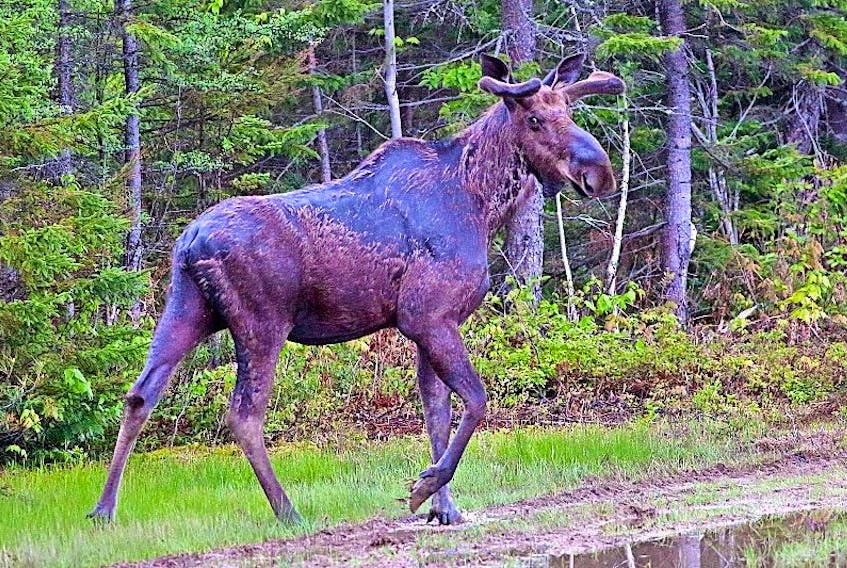The charitable organization is conserving habitat on the narrow isthmus, the only land bridge between Nova Scotia’s endangered population of indigenous moose and the much larger moose population in New Brunswick.
The ultimate goal of the fifth annual Help the Moose Cross the Isthmus for Christmas campaign, also known as the Moose Sex Project, is to help the lonely moose of Nova Scotia find mates.
“In science sense we’re trying to prevent Nova Scotia from becoming an ecological island, dividing our wildlife populations from the rest of the continent,” NCC Nova Scotia program director Craig Smith said. “We have to do whatever we can to maintain to protect the habitat on the isthmus.”
The tongue-in-cheek campaign has a serious purpose: to create a protected and ecologically intact wildlife corridor on the isthmus to allow moose and other animals to move freely between New Brunswick and Nova Scotia.
Smith said if there’s someone on the hard to buy for list a donation in their name to the Moose Sex Project would be an unforgettable Christmas gift.
“By helping NCC conserve a wildlife corridor between Nova Scotia and New Brunswick, you can make a difference for Nova Scotia’s endangered mainland moose and many other animals as well,” he said.
Only 23 kilometres wide at its narrowest point near the Nova Scotia/New Brunswick border, the Chignecto Isthmus is becoming more densely populated and fragmented by roads, with development pressures reducing the ability of wildlife to migrate between the two provinces.
While some areas on the isthmus are becoming more developed, other areas include forested wilderness that supports Nova Scotia’s largest remaining group of mainland moose. Designated endangered in 2003, Nova Scotia’s mainland moose population has declined to an estimated 500 to 1,000 individuals. By contrast, New Brunswick’s moose population is estimated at 29,000.
Over the past five years, through a combination of private donations and government support, the NCC’s Moose Sex Project has succeeded in conserving more than 1,214 hectares acres of land on and around the Chignecto Isthmus.
That’s on top of more than 4,000 hectares protected by Nova Scotia.
“I’d say we’re about halfway to what we in our original conservation plan for northern Nova Scotia identified as a 25,000-acre core protection area along the isthmus,” Smith said. “We are eagerly awaiting the announcement of the permanent protection of the remaining parts of the Chignecto Isthmus Wilderness Area.”
This year, NCC is using motion-activated video cameras near the Nova Scotia and New Brunswick border to track the movement of wildlife in order to determine future priority areas for conservation. Conserving an ecologically-intact wilderness corridor between Nova Scotia and New Brunswick — and providing connectivity is valuable for the genetic diversity and health of many animals, and is especially essential for the long-term survival of Nova Scotia’s mainland moose.
The charitable organization is conserving habitat on the narrow isthmus, the only land bridge between Nova Scotia’s endangered population of indigenous moose and the much larger moose population in New Brunswick.
The ultimate goal of the fifth annual Help the Moose Cross the Isthmus for Christmas campaign, also known as the Moose Sex Project, is to help the lonely moose of Nova Scotia find mates.
“In science sense we’re trying to prevent Nova Scotia from becoming an ecological island, dividing our wildlife populations from the rest of the continent,” NCC Nova Scotia program director Craig Smith said. “We have to do whatever we can to maintain to protect the habitat on the isthmus.”
The tongue-in-cheek campaign has a serious purpose: to create a protected and ecologically intact wildlife corridor on the isthmus to allow moose and other animals to move freely between New Brunswick and Nova Scotia.
Smith said if there’s someone on the hard to buy for list a donation in their name to the Moose Sex Project would be an unforgettable Christmas gift.
“By helping NCC conserve a wildlife corridor between Nova Scotia and New Brunswick, you can make a difference for Nova Scotia’s endangered mainland moose and many other animals as well,” he said.
Only 23 kilometres wide at its narrowest point near the Nova Scotia/New Brunswick border, the Chignecto Isthmus is becoming more densely populated and fragmented by roads, with development pressures reducing the ability of wildlife to migrate between the two provinces.
While some areas on the isthmus are becoming more developed, other areas include forested wilderness that supports Nova Scotia’s largest remaining group of mainland moose. Designated endangered in 2003, Nova Scotia’s mainland moose population has declined to an estimated 500 to 1,000 individuals. By contrast, New Brunswick’s moose population is estimated at 29,000.
Over the past five years, through a combination of private donations and government support, the NCC’s Moose Sex Project has succeeded in conserving more than 1,214 hectares acres of land on and around the Chignecto Isthmus.
That’s on top of more than 4,000 hectares protected by Nova Scotia.
“I’d say we’re about halfway to what we in our original conservation plan for northern Nova Scotia identified as a 25,000-acre core protection area along the isthmus,” Smith said. “We are eagerly awaiting the announcement of the permanent protection of the remaining parts of the Chignecto Isthmus Wilderness Area.”
This year, NCC is using motion-activated video cameras near the Nova Scotia and New Brunswick border to track the movement of wildlife in order to determine future priority areas for conservation. Conserving an ecologically-intact wilderness corridor between Nova Scotia and New Brunswick — and providing connectivity is valuable for the genetic diversity and health of many animals, and is especially essential for the long-term survival of Nova Scotia’s mainland moose.









